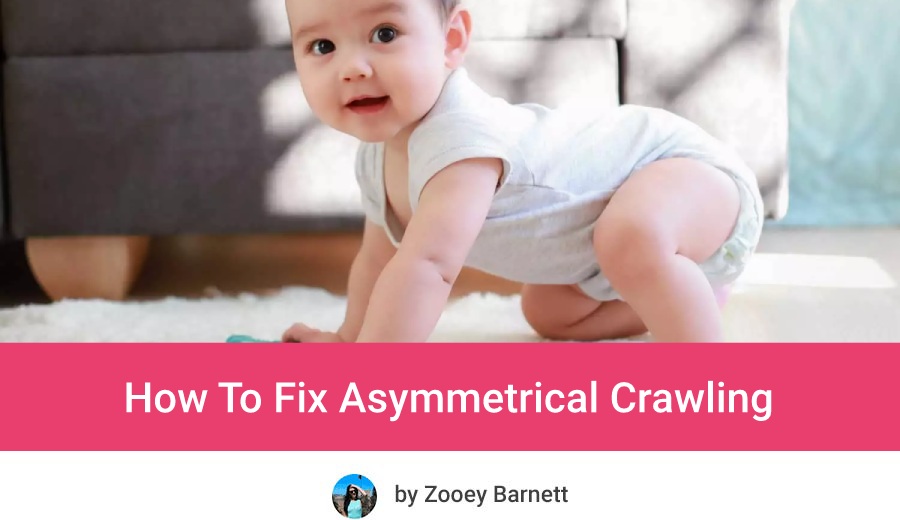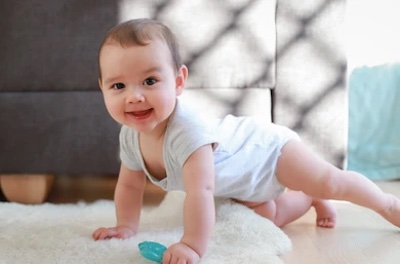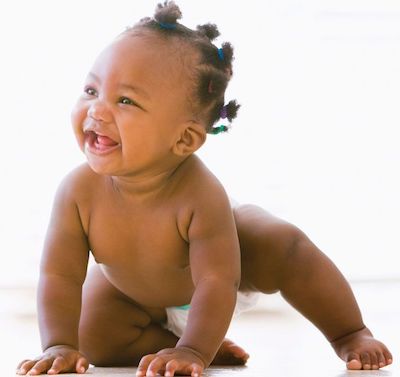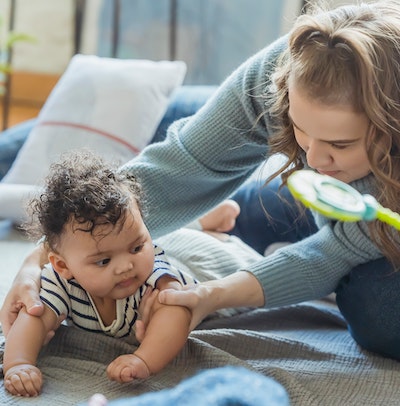
Crawling is an exciting stage in your baby’s growth and development. It marks the first time they start to move independently on their own. However, your little one may face development issues along the way, and one of the most common ones is asymmetrical crawling.
I’m sure that as a parent, you want to make sure your child is healthy and develops properly. If you have noticed that your baby’s crawling seems a bit unusual and are worrying if this is serious, this article is for you.
I will try to cover everything you need to know about asymmetrical crawling. First, you need to know how a “normal” baby crawl looks like. This will help you understand better when you see an atypical crawling. Then, I will explore all possible causes and how to fix asymmetrical crawling.
This article is not a substitute for medical advice.
Why Is Crawling An Important Milestone?
Hands and knees crawling is considered the first skill that provides infants with independent mobility. Infants usually begin crawling between 6 and 9 months, and this expands their opportunities for interaction with people and objects around them.
Baby crawling is an important milestone that sets the foundation for higher level motor skills such as walking, running, climbing and other important future skills.
Crawling is important for babies because it helps them get stronger, see better, have better body awareness, and coordinate both sides of the body. This helps babies develop strength on their hip muscles and motivates them for further motor skills.
| PRO TIP: Proper crawling facilitates cognitive development, helps to practice visual skills, and coordination of both sides of the body. That why it’s so important to encourage babies to crawl (in the proper way) and you can use some toys for that! Check out my favorite best toys for crawling babies >> |
Typical Crawling – How Does It Look Like?
First let’s see how the symmetrical crawling looks like.
Babies typically start crawling by getting up on their hands and knees, in an “all fours” position, and then moving forwards or backwards. There should be reciprocal movement of the limbs, moving the right arm at the same time as the left leg, and the left arm the same time as the right leg. This is considered normal crawling.
Other characteristics of normal crawling include: using both sides of the body equally, advancing one knee at a time, knees are lined up under baby’s hips, stance is not too wide, core is engaged, the back is not too arched and the tummy is not too rounded1.
It is very important that babies crawl properly, as this is a critical developmental milestone for their future motor skills. Proper crawling technique helps to develop symmetry in the body, which is important for a baby’s overall physical development.
Proper crawling also develops strength in the shoulder, neck, abdominal and hip muscles, which improves general muscle tone and prepares baby’s muscles for his/her first steps.
Asymmetrical Crawling
Asymmetrical crawling is an abnormal crawling pattern where your baby favors one side of the body during movement. You may be wondering why is your baby crawling with one leg tucked in, or why is your baby crawling in other unusual ways.
This can seriously affect your baby’s development, so keep on reading to understand underlying causes and how to fix asymmetrical crawling.
What Does Asymmetrical Crawling Look Like?
Essentially, asymmetrical crawling looks different from a typical crawling pattern, where a child alternates their arms and legs to move forward. When a child crawls asymmetrically, he or she appears to drag one part of their body as they move forward.
Characteristics of asymmetrical crawling2:
- Baby crawls using one foot and one knee, instead of two knees.
- Baby’s pelvis and spine shifts to one side.
- Babies will use one hand and one knee to move forwards, “dragging” the other foot .
- When reaching for toys, he or she prefers to use the same hand all the time.
However, your baby’s asymmetrical movements might not include all the above characteristics, as there are many different patterns of asymmetrical crawling which we will be addressing below.

Asymmetrical Crawling Patterns
There are a number of different asymmetrical crawling patterns which include:
- Club crawling or baby crawling with one leg tucked in, is a type of crawling where the kid uses only one leg to crawl and drags the other (hence the other name: one legged crawling).
- Bear walking or bear crawling is a type of crawling where instead of hands and knees, baby crawls on their hands and feet, with their knees straightened and their bottom up.
- Bunny hop crawling where both knees hop forward and tuck under the baby’s chest when crawling.
- Hitch crawling when a baby hitches a leg out on the side in order to move forward.
- Crab walking when a baby crawls using their hands to propel himself/herself forward, placing weight on one leg while bending the other.
- Bottom scooting is a type of asymmetrical crawling where the baby is sitting instead on “all fours”, and using hands or sometimes pulling with heels to move forward.
- Frog leg crawling when babies crawl with their knees very far apart. This type of asymmetrical crawling takes a lot of effort, and your baby may prefer not to do it.
- Commando crawling or also known as belly crawl is often the first type of crawling position when babies start crawling. Commando crawl is usually normal in the beginning, and only considered an asymmetrical crawling when it persists3.
It is important to notice that many of these crawling types mentioned above are temporary, and do not necessarily cause issues later. Nevertheless, if this type of asymmetrical crawling persists, it may lead to muscle and skeletal problems.
How Does Asymmetrical Crawling Impact Baby’s Development?
Asymmetrical crawling can have a negative impact on your baby’s development4. Crawling is essential for further progression of motor skills such as walking and running. Proper crawling is also important for healthy cognitive development and baby’s body awareness. Therefore, it is important to correct asymmetrical crawling as early as possible.
Asymmetrical crawling can cause muscle imbalance, meaning that the hip girdle muscles develop differently in two sides of the body. This causes weak muscles on one side, which can affect future skills such as standing or walking.
Neck, shoulder and abdominal muscles are also affected. Baby’s asymmetrical crawling can result in low muscle tone, which may cause difficulties with balance and other motor skills.
Another issue that may arise in a baby crawling asymmetrically is a condition called scoliosis. Fortunately, this is not very common unless asymmetrical crawling persists for a longer period.

Why Does My Baby Crawl Asymmetrically?
There are a lot of reasons why a baby crawls asymmetrically. For most of them this is only a temporary phase until they learn to use their hands and knees to crawl properly. Sometimes, they are only experimenting and practicing their motor skills. Therefore, they usually self correct themselves or only need minimal assistance.
A common reason why an infant may crawl asymmetrically at the beginning is that their knees are sore from touching the floor. Special clothing with padded knees, such as crawling pants, can help with this. You can also get a crawling mat – best if it’s a non-toxic baby mat – that provides proper support and cushion for little crawler’s knees (and bum!).
However, there are also many cases where baby’s lopsided crawling is a bit more complicated problem. Some babies may have developmental delays or weak vision, which can cause them to crawl asymmetrically.
Vision impairment can cause abnormal crawling patterns, as it affects their ability to perceive and plan movements. It is important to have a proper diagnosis in this case, as this can cause long term problems.
Poor muscle tone, pelvis issues or problems with their hip joints can also cause similar problems. This happens because their legs hurt or are not strong enough to support them while crawling. That’s why infants crawl while dragging the part of the body that brings discomfort.
Certain other factors, such as autism spectrum disorders or cerebral palsy, can make infants more likely to crawl differently. However, it must be emphasized that asymmetrical crawling alone is not a sign of either of these conditions.
Is Asymmetrical Crawling Normal?
Asymmetrical crawling is usually considered normal if it’s temporary and is not associated with muscle imbalances, joint problems or cognitive delays. It is also considered normal at the beginning, when infants are still trying to learn to crawl. In many cases, this resolves on its own as infants gain more experience and improve their motor skills.
However, if this persists, it is advisable to consult your child’s doctor for further evaluation. A pediatrician will investigate all possible causes and can rule out any potential concerns.
Do Babies Grow Out Of Asymmetrical Crawling?
Every child is unique and their development may vary. But, as I mentioned earlier, asymmetrical baby crawling often is a temporary phase and many babies grow out of it on their own. However, it is very important that underlying causes are ruled out by a pediatrician, especially for long term asymmetrical crawling.
Does Asymmetrical Crawling Mean Autism?
While it is true that autistic children may show deviations from a normal crawling pattern, asymmetrical crawling alone is not a sign of autism. Autistic children usually manifest typical signs such as: slow or no reflexes, minimal eye contact, absence of gestures and emotions. Asymmetrical crawling can be linked to autism, only in the presence of these typical signs5.
Should I Fix Asymmetrical Crawling?
If you notice your baby’s crawls look different from their peers, you should first try to understand why it is happening. Try to see if one of the patterns mentioned earlier matches your child’s crawling. This way, you can better understand why is it happening, and what you should do.
If your baby has just started crawling, and you notice an asymmetrical pattern, give it some time to see if they self correct. If this persists for a few weeks, it would be best to record your child’s crawling and have a consult with your child’s doctor.
Your child’s crawling style shouldn’t be concerning if it is self-corrected in a few days.

Tips For Fixing Asymmetrical Crawling Pattern
You could try a few tips on how to fix asymmetrical crawling.
- Encourage your child to reach the toys he/she is interested in
Put interesting toys at a short distance from your child and encourage the baby crawl calling them or trying to give them something they find interesting. Put these toys in their less favored side to encourage the use of that side of the body.
- Crawl with your baby
Child proof your home, then join them on the ground and demonstrate the proper way to crawl. Children learn everything faster by imitating our behaviors rather than telling them something. So, try to play with them by crawling the way they should crawl and maybe they’ll join you.
- Set up some obstacles
Your child will find it challenging to crawl asymmetrically if they have to crawl over pillows or objects. Doing it will strengthen their muscles and make it easier to properly crawl6.
- Correct baby’s position
Another method that corrects asymmetrical crawling is to gently swoop that one leg (that is not in the correct position) back to a knee crawling position.
How To Help Baby Crawling
There are a lot of tools that could help with your child’s irregular crawling.
- Use physioball
For starters, take a physioball and try to put your child in there with their belly lying down while you hold them not to fall off. This will help strengthening their muscles by making them use both sides of their body.
- Plenty of tummy time
Play with your child while in a tummy position, which can help strengthen their core and improve their overall motor development.
- Help baby get into the right position
Try to put the leg that they are dragging in the right position, until they do it for themselves.
- Try crawling pants
Special clothing such as crawling pants with padded knees can make it less painful for your baby to use their knees. This can be especially helpful at the beginning when baby’s knees are not yet used to hitting the floor frequently.
When Should You Be Concerned About Your Child Crawling Asymmetrically & Talk To A Doctor?
Each baby, no matter how little they are has their own personality, and sometimes these crawling patterns are just the way they want to do things and nothing to worry about. Every baby develops at a different pace and learns to crawl in a different way.
Although it might look atypical, every asymmetrical crawl pattern is not a cause for alarm, if it’s just temporary. Sometimes it is just your baby’s special way of moving, they might find it easier or even like it better.
However as a parent, it is normal to worry. Some types of asymmetrical crawling can cause some serious health issues later in life.
It might cause a number of physical development problems, such as: spine deformity or scoliosis, shifted hip girdle and pelvis, difficulties with visual orienting, difficulties with balance and body awareness later when learning to walk, as well as improper muscular growth.
You can never completely rule out medical issues, so if your child’s crawl doesn’t get better even if you used all those tricks, you should consult with a doctor.
The purpose of this article is informative. It’s not a substitute for professional medical advice or medical care. Remember: safety first! Consult your doctor/pediatrician in case of any doubts. The author of this article does not accept any responsibility for any liability, loss or risk, personal or otherwise, incurred as a consequence, directly or indirectly, from any information or advice contained here. This article contains affiliate links.
Resources:
https://www.chicagopediatrictherapyandwellness.com/
https://www.ncbi.nlm.nih.gov/
https://www.healthychildren.org/
https://www.pnas.org/
https://theinspiredtreehouse.com

